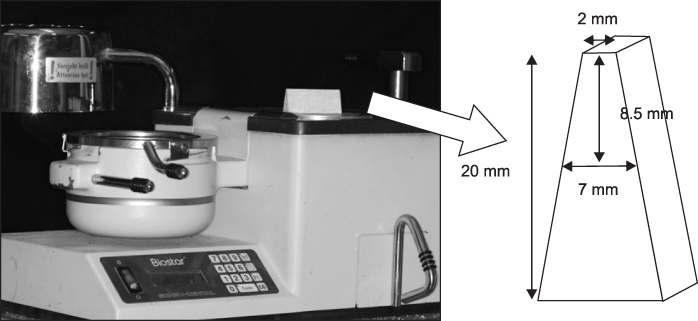Korean J Orthod.
2010 Feb;40(1):16-26. 10.4041/kjod.2010.40.1.16.
The effect of thickness and deflection of orthodontic thermoplastic materials on its mechanical properties
- Affiliations
-
- 1Department of Orthodontics, College of Dentistry, Yonsei University, Korea. jungcha@yuhs.ac
- 2Department of Orthodontics, College of Dentistry, Oral Science Research Institute, The Institute of Cranio-facial Deformity, Yonsei University, Korea.
- 3Department of Dental Biomaterials and Bioengineering, College of Dentistry, Yonsei University, Korea.
- KMID: 1975619
- DOI: http://doi.org/10.4041/kjod.2010.40.1.16
Abstract
OBJECTIVE
The purposes of this study were to evaluate the force and stress depending on the type, deflection and thickness of the materials and to evaluate the mechanical properties of thermoplastic materials after repeated loading.
METHODS
Four types of thermoplastic products were tested. Force until the deflections of 2.0 mm and the stress when the materials were restoring to its resting position were evaluated. The mechanical properties of thermoplastic materials evaluated after 5 repeated loading cycles.
RESULTS
The interaction was observed between the thickness and the deflection (p < 0.05) from the regression equation. Thickness and amount of deflection rather than products and materials showed the largest effect on force and stress. In all products, at least 159 gf of force was required for more than 1.0 mm deflection or when materials with 1.0 mm thickness were deflected. The stress recorded was more than 19 gf/mm2. During repeated loading, each group showed significant difference on the force and the stress p < 0.01), 10 - 17% reduction of force and 4 - 7% reduction of stress in average.
CONCLUSIONS
Proper thickness of thermoplastic materials and deflection level of tooth movement should be decided for the physiologic tooth movement. Force decay after repeated loading should be considered for the efficient tooth movement.
Keyword
MeSH Terms
Figure
Cited by 2 articles
-
Effects of thermoforming on the physical and mechanical properties of thermoplastic materials for transparent orthodontic aligners
Jeong-Hyun Ryu, Jae-Sung Kwon, Heng Bo Jiang, Jung-Yul Cha, Kwang-Mahn Kim
Korean J Orthod. 2018;48(5):316-325. doi: 10.4041/kjod.2018.48.5.316.Force and moment analysis of clear aligners: Impact of material properties and design on premolar rotation
Dong-Woo Kim, Hyun-Jun Lee, Ki Beom Kim, Sung-Hun Kim, Seong-Sik Kim, Soo-Byung Park, Youn-Kyung Choi, Yong-Il Kim
Korean J Orthod. 2025;55(3):212-223. doi: 10.4041/kjod24.114.
Reference
-
1. Rinchuse DJ, Rinchuse DJ. Active tooth movement with Essix-based appliances. J Clin Orthod. 1997. 31:109–112.2. McNamara JA, Kramer KL, Juenker JP. Invisible retainers. J Clin Orthod. 1985. 19:570–578.3. Ponitz RJ. Invisible retainers. Am J Orthod. 1971. 59:266–272.
Article4. Kesling HD. The philosophy of the tooth positioning appliance. Am J Orthod. 1945. 31:297–304.
Article5. Nahoum HI. The vacuum formed dental contour appliance. NY State Dent J. 1964. 9:385–390.6. Fernandez Sanchez J, Pernia Ramirez I, Martin Alonso J. Osamu active retainer for correction of mild relapse. J Clin Orthod. 1998. 32:26–28.7. Yoshii O. Introducing in new retainer-soft retainer and case reports. J Orthod Pract. 1992. 8:25–42.8. Sheridan JJ, LeDoux W, McMinn R. Essix retainers: fabrication and supervision for permanent retention. J Clin Orthod. 1993. 27:37–45.9. Boyd RL, Miller RJ, Vlaskalic V. The Invisalign system in adult orthodontics: Mild crowding and space closure cases. J Clin Orthod. 2000. 34:203–212.10. Bollen AM, Huang G, King G, Hujoel P, Ma T. Activation time and material stiffness of sequential removable orthodontic appliances. Part 1: ability to complete treatment. Am J Orthod Dentofacial Orthop. 2003. 124:496–501.
Article11. Chenin DA, Trosien AH, Fong PF, Miller RA, Lee RS. Orthodontic treatment with a series of removable appliances. J Am Dent Assoc. 2003. 134:1232–1239.
Article12. Vlaskalic V, Boyd R. Orthodontic treatment of a mildly crowded malocclusion using the invisalign system. Aust Orthod J. 2001. 17:41–46.13. Lee GW, Kim HJ. Tooth morphology. 1997. Seoul: Jisung;126–146.14. Kwon JS, Lee YK, Lim BS, Lim YK. Force delivery properties of thermoplastic orthodontic materials. Am J Orthod Dentofacial Orthop. 2008. 133:228–234.
Article15. Ryokawa H, Miyazaki Y, Fujishima A, Miyazaki T, Maki K. The mechanical properties of dental thermoplastic materials in a simulated intraoral environment. Orthodontic Waves. 2006. 65:64–72.
Article16. Gardner GD, Dunn WJ, Taloumis L. Wear comparison of thermoplastic materials used for orthodontic retainers. Am J Orthod Dentofacial Orthop. 2003. 124:294–297.
Article17. Tuncay OC. The invisalign system. 2006. Graften road, New Malden: Quintessence Publishing Co, Ltd;187–194.
- Full Text Links
- Actions
-
Cited
- CITED
-
- Close
- Share
- Similar articles
-
- Effects of thermoforming on the physical and mechanical properties of thermoplastic materials for transparent orthodontic aligners
- A new type of clear orthodontic retainer incorporating multi-layer hybrid materials
- Changes in force associated with the amount of aligner activation and lingual bodily movement of the maxillary central incisor
- A study on the mechanical properties of orthodontic open coll springs
- Mechanical properties of nickel titanium and steel alloys under stress- strain test





